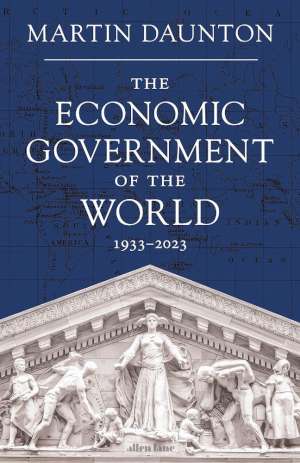24 November 2023
The Economic Government of the World, 1933‑2023
Martin Daunton
2023, Allen Lane, 986 pages,
ISBN 9781846141713
Reviewer: Ian Harwood

The Holy Grail of international economic cooperation is, woefully, in short supply at present. The world is grappling with the post-pandemic fallout of high inflation, huge public debt and elevated economic uncertainty. There is, moreover, outright armed conflict in Ukraine and the Middle East and resurgent geo-political tension. Exceptionally daunting challenges lie ahead and there are considerable question marks over whether our current crop of politicians worldwide can successful surmount these. Every generation, however, tends to believe that the scale of challenges it faces vastly surmount those of its forebears. In such circumstances the publication of Martin Daunton’s “The Economic Government of the World, 1933-2003” is especially timely, affording as it does an invaluable perspective on the past greatly fluctuating fortunes of international economic and financial cooperation.
This is an exceptionally hefty book, both in terms of its length (it runs to almost 1,000 pages) and its panoramic scope. It is, moreover, immensely detailed in its telling of the story of the evolution of the critical economic and financial inter-relationships between the world’s major economies over the course of the past century. Hopefully, however, the book’s length won’t put people off. It is well worth reading – especially for those whose knowledge of such history is patchy or, even, non-existent.
Daunton’s methodological approach is to focus throughout solely upon the actions of key decision-makers which were, of course, inevitably dictated by considerations of national self-interest (though considerations of “enlightened” self-interest occasionally intrude). In so doing he covers a very considerable amount of historical ground as he outlines how pivotal decisions within government – principally by finance ministers and central bankers – were reached and, in particular, the role played by (evolving) economic ideas.
Daunton’s narrative begins by relating how the gold standard-based pre-1914 international economic order broke down with the advent of the First World War and how post-war efforts to revive and essentially “turn back the clock” were frustratingly unsuccessful before foundering wholesale on the rocks of the Great Depression of the early 1930s.
His substantive starting point is to examine why the World Economic Conference of 1933 – a last-gasp attempt to avoid the world splintering into separate and divisive economic blocs – proved such a shockingly dismal failure. As someone who has never fully understood exactly what happened all those years ago, I found his analysis exceptionally insightful.
He then discusses how Allied victory in World War Two enabled the Bretton Woods agreement – and its creation of multi-lateral institutions whose purpose was to bind the world economy closely together – to be implemented.
Such a set-up, of course, faced its own problems and the third part of the book focuses upon the tensions which increasingly bedevilled these post-WW2 arrangements and eventually produced the terminal breakdown in the early 1970s of the Bretton Wood currency arrangements prior to the arrival of the first oil price hike, double-digit inflation rates and the first “true” global recession of the post-WW2 period.
The final part of the book addresses how the currently dominant “neo-liberal” regime came to be established. Disruptively high inflation was brought under control, the role of the state was cut back and “market forces” came increasingly into play. Meanwhile, geo-political tensions thawed with the liberalisation of China’s economic model, the disintegration of the Soviet Union and the sanguine implications of Fukuyama’s “End of History”. Against such an enabling background, “globalisation” and “financialisation” thrived to a hitherto unparalleled degree until the Global Financial Crisis threatened a repetition of the Great Depression.
No author – in concluding a tale of this sort – is likely to avoid offering his speculations as to what the future may hold. The author (understandably by dint of specialist knowledge of both the past and the current conjuncture) is likely to consider himself exceptionally qualified to undertake a task of this sort. Furthermore, it seems highly improbable that any self-respecting publisher would let the author off this particular hook to ensure that the book seems as relevant as possible to the current concerns of the book-buying public. Thus, Daunton’s final chapter – entitled “The Way Ahead” – sets out an exhaustive list of current challenges – ranging from competition and tax policy, employment, trade and capital flows, a Green New Deal, competing currencies, reforming economics to the politics of China, the Eurozone and the US. For the author, though, it is the dysfunctional politics of the latter which currently constitutes the most serious “clear and present danger”.
